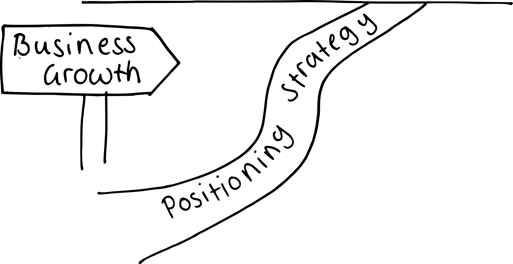Earlier in the year, I wrote this article about why a Corporate Positioning Strategy is essential for all businesses and how to run a Corporate Positioning Strategy Workshop. I believe passionately that having a clear, well understood Positioning Strategy, is more important now than ever. So, given that many of us are currently working remotely from each other, in this article I am going to explore how to run a virtual workshop to write a Positioning Statement.
What is a Positioning Statement?
Firstly, lets remind ourselves of what exactly a Positioning Statement is:
Very simple. But extremely powerful. Essential in fact.
“Nobody buys a product or service because it can do everything, but because it can do something.” Tim Williams
Why is a Positioning Strategy Essential?
A positioning strategy provides:
- A key focus for your business.
- Direction for your business.
- A borderless market.
- A clear target market.
- An efficient and targeted sales process.
- The ability to charge premium pricing.
Or as Dan Tyre of HubSpot says, “The Riches are in the Niches”. (Note: needs to be said so that it rhymes! For more of Dan Tyre’s wisdom please read 5 Invaluable Business Growth Lessons from HubSpot’s Dan Tyre.)
For more detail about the benefits of a positioning strategy check out this article.
So, what’s the problem? Why wouldn’t you agree your Positioning Strategy?
Why your Company Might not have a Position Strategy
When you think about it, it’s hard to see how a business could be successful without a Positioning Strategy, so why might your company not have one?
Well it could be any one of the following – or perhaps a combination of all four.
- It hasn’t been got around to.
- Things have changed, and it needs revisiting.
- Fear - it means committing to saying no to people, committing to making your company less appealing to everyone. This can be scary.
- It’s hard to agree a clear Positioning Strategy.
Whatever the reason, it is important to agree a strategy, and the best way to do this is by holding a Corporate Strategy Workshop.
How to run a Virtual Positioning Strategy Workshop
Preparation
As with anything in life, running a successful Positioning Strategy Workshop requires planning. All of the following are essential pre-workshop preparation steps:
Invite the key stakeholders. A Positioning Strategy must be agreed at an Executive level, so it is essential that the key board members are invited. It is also essential that they start the workshop fully bought into the concept and prepared to participate in full.
Decide the timeframe (and stick to it!), ensuring the scope of the workshop fits into the timeframe. At D2e we schedule our in-person workshops for 4 hours, but 2 hours is the absolute maximum for a virtual meeting, with 1 hour the optimal length of time. So we book a series of 1 hour virtual meetings for a Virtual Positioning Strategy Workshop - and set a scope for each one.
Invite someone to be the scribe on the day (they should be someone who’s not going to be too deeply involved in the discussion) and plan for how the scribe will capture the discussion - just on their notepad or shared with the meeting on screen? It is also useful to record the discussion - easily done with a virtual meeting.
Choose your virtual meeting software carefully and consider what will work best for everyone - chances are you have your favourite already, but ensure everyone else is happy with it.
Consider how you are going to manage the following practicalities:
- Visual – everyone being able to see each other is ideal, but is it more important that everyone can see the discussion points and should this take precedent over being able to see everyone?
- Speaking - would you like everyone to be on mute until they speak? Are you going to ask people to contribute in turn or just to chip in when they want to?
What you decide in terms of practicalities will depend on what you are comfortable with, the culture of your organisation and what is likely to work best. The key thing is to decide how you are going to run things in advance and let all participants know the 'rules of engagement'. You may also wish to asking for full participation – no checking of e-mails during the meeting!
Send out the meeting invitation well in advance and consider scheduling some set up and testing time for participants. If they haven’t used the meeting software beforehand (which won't often be the case these days) they will need to download it and check out that everything is working in advance – visual and audio, so this does not run into your meeting time.
The Workshop
Start the workshop by welcoming everyone and reminding them what you are setting out to achieve. Make sure everyone can participate in the discussion by giving them time and focus and asking for everyone's input.
Remember that although ultimately your Positioning Strategy needs to align with all your company growth plans, put all concerns about this aside to start. It is also key not to jump into trying to write a Positioning Statement too quickly.
A really helpful template for a Positioning Statement is as follows.
We provide this value/outcome [The What] for this type of company/industry/market [The Who] by providing this type of product/service [The How] because why [The Why].
But although everyone should know that completing this is the end goal of the workshop, as mentioned before don’t let them jump straight to that.
Each person will probably have come to the workshop with an idea of what the company’s Positioning Strategy should be. Asking and discussing the following questions will enable a consensus to be reached and in my experience the end result will probably be both different from everyone’s expectation at the start of the workshop - and far more exciting!
Questions to ask:
The Why
- Besides profits why does our company exist?
- What would people miss if our company didn’t exist tomorrow?
- What inspires us all to go to work everyday?
- What is the purpose and meaning of what our company does?
- What problems does our company solve?
- If we (the staff) were volunteers instead of employees what would we be volunteering for?
The Who
- What type of customers have our company been most successful with in the past?
- What traits do they have in common?
- Which market segment do we know best and excel at?
- Which type of companies do we enjoy working with most?
- Which type of customers do we not want to do business with?
The What
Where is our company currently seen as an expert or thought leader?
- Where do our organisation’s products/services provides the most value to customers?
The How
- What are the philosophies our organisation follows when developing products/services?
- What is unique about our organisation’s offering?
- What is the one thing our organisation would never change about its offering?
Use a PowerPoint to keep you on track with this questioning, but keep in mind that the PowerPoint is not a presentation - just a way of ensuring everyone can see the question being considered - and that the questions as set out aren’t the whole story. The real value will be in the follow-on exploration and deeper probing of those questions - that is what will move the discussion forward.
"D2e's facilitation of their Corporate Strategy Workshop, combined with their insights into the business challenges Triaster is grappling with were highly important. The questions themselves were insightful, but it was the follow-on exploration and deeper probing of those questions that really moved us forward." Michael Cousins, Managing Director, Triaster Ltd
Once these questions have been discussed and answered, review the answers and then have a go at writing your positioning statement, by filling in the gaps in the template.
We provide this value/outcome [The What] for this type of company/industry/market [The Who] by providing this type of product/service [The How] because why [The Why].
You won’t get to a perfect Positioning Statement the first time, but write down each version and build on it. The key thing is to check that it’s got enough detail in it to be meaningful.
This is D2e’s Positioning Statement:
We create custom inbound-ready websites optimised for lead generation for B2B companies, by combining Growth-Driven Design and the HubSpot platform, because a company’s website is essential to delivering on their business goals.
This is one of our client’s:
We hunt down and fix processes which are clearly broken for B2B enterprises, by innovating and developing powerful, easy-to-use, end-user centric software, because their staffs’, customers’ and suppliers’ time and well-being is precious.
Both were reached by following the process and asking the questions set out above. Both were the start of something amazing.
 Now what?
Now what?
It is important to understand that a Positioning Strategy won’t help you much if you don’t tell anyone about it or do anything with it. In fact, if that is the case, it won’t help you at all.
The value of your Positioning Strategy is in providing direction for everyone in your company. So, take the time to tell them about it, discuss and explain it to them and how it enables them to move forward boldly with developing your products and services and marketing your company.
You will never regret the time you spend on this.






